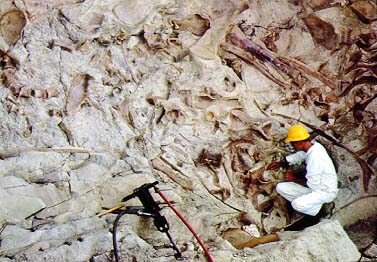



Dinosauria: Fossil Record
 A worker at Dinosaur National Monument in Utah pauses during an excavation of one of the many dinosaur bones preserved there. |
Dinosaur fossils had been known for centuries as "dragon bones" or the remains of giants, but it wasn't until Dean William Buckland of Oxford, England described the carnivorous "lizard" Megalosaurus (in 1824) that they were formally studied as an extinct group of giant reptiles. The English country doctor Gideon Mantell described Iguanodon in 1825, and today there are more than 800 known types of non-avian dinosaurs (plus some 10,000-plus birds).
The term "Dinosauria" was invented by Sir Richard Owen in 1842 to describe these "fearfully great reptiles." The irony of Owen's invention of Dinosauria is that he devised the taxonomic group as an argument against progressive evolution, but actually had presented evidence supporting evolution.
Although dinosaur remains had been found earlier elsewhere, it was the discoveries of dinosaurs in North America in the second half of the 1800s that provided the first real glimpse of what these animals were like, and gave paleontologists some clues about the past diversity of life on Earth. The late 1800s were the "golden age" of dinosaur paleontology, when many animals that you might be familiar with were discovered and named. Today we seem to be in another "dinosaur renaissance," with new information accumulating rapidly.
The first dinosaurs, in the Late Triassic period (about 230 million years ago), apparently were not major components of the fauna. However, by the Early Jurassic (about 30 million years later), after many other Triassic vertebrates had gone extinct, dinosaurs were diversifying rapidly. By then they had become dominant occupants of many major terrestrial adaptive zones, judging from their frequently large size and considerable morphological and taxonomic diversity. The Late Jurassic (about 145 million years ago) through the Late Cretaceous (about 65 million years ago) was the heyday of the dinosaurs. It was also the Late Jurassic that saw the bird lineage diverge from its flightless theropod ancestors, and birds enjoyed an explosion in diversity in the Cretaceous period and beyond.